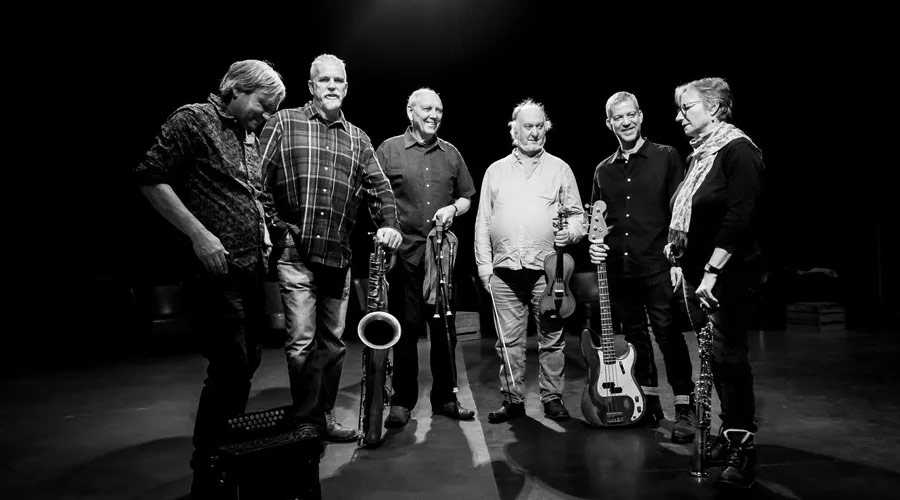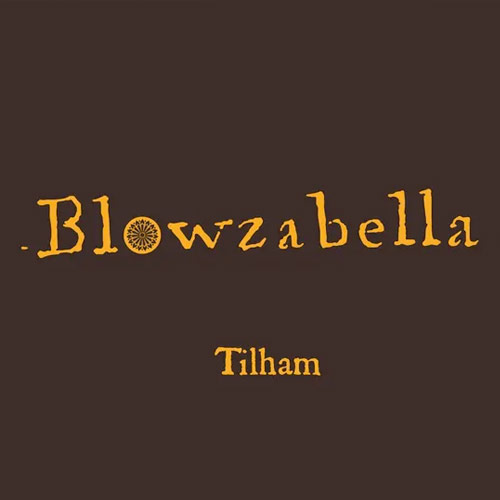BLOWZABELLA
Tilham
A brief drone on the pipes; a riff on Dave Shepherd’s fiddle; a driving bassline from Barn Stradling, then we’re off with a surefooted melody on the pipes and whistles. It’s a classic start to a Blowzabella album, and as is so often the case on their dancefloor, we are opening with a schottische. Dancers whirl as if in formation, yet they are free, embellishing with variations.
Yes, we’re going on board the Blowzabella and it’s a new album, but many of these pieces have been long in the forge, some being roadtested since 2018’s Two Score. Some were already out there in tunebooks, being picked up in sessions around the country even from before you-know-what. And there can be few bands containing such talent for a dance tune. Every band member can write solid gold floorfillers, though the credits show that Jon Swayne is the one on top form with this album, with four writing credits over twelve tracks. Having co-written that opener (Remembering Patrick / Nephew Greg) with Dave Shepherd, he takes the full credit for the following waltz, The Hawthorn Tree / The Bell, which is as good as any exhibition of why Blowzabella have had such a devoted following. A gentle clarinet introduces the tune, picked up by the fiddle to a dancing pace until a joyous chime of border pipes waltzes the tune around the room. Andy Cutting steps centre stage, diatonic accordion as sensitive as ever, until that perfect blend of mellow pipes returns. The arrangement is joyous, divine even, melodies and dancers swirling. Jon doesn’t just get the credit for tunes either, for he makes the Border pipes that he and bandmate Paul James play.
Both Jo and Dave bring us processional dances. The geography can get a little confusing. Jo’s Kesteven Processional actually works far from Lincolnshire in the Helston Furry Dance, but her take is altogether more stately than the Floral Dance that would typically accompany traditions in Cornwall. Dave’s processional is named after Baltonsborough in Somerset, which brings it all home for the band. This is the village where they habitually open their live season with a village hall gig each January, being the home of band founder Jon Swayne. It is also home to the eponymous Tilham Farm where the album was recorded.
As well as traditional dance forms, naturally Blowzabella will also play with traditional songs and tunes, repurposing them for dance. Paul James has previously found inspiration in Vaughan Williams’ collecting, when he had dancers snaking an an dro to Bushes and Briars. That song shares DNA with The Green Bushes, but this time you will be waltzing your partner round the floor. Jo Freya also takes us to the Vendee for a rondeau in the company of Les Trois Jolis Mineurs, before a Paul James tune nicely rounds off the dance.
Jo is as steeped in French as English dance music. She names one of her tunes, Neylis, after her house in the Ariege, way down in the foothills of the Pyrenees, but the spiritual home of the music is undoubtedly Brittany. Fiddle, clarinet and melodeon are in unison, taking on perpetual motion, while the saxes embellish. It has the hypnotic quality of the best Breton tunes leading dancers in a trance. But will they hear an an dro or perhaps a kaz-a-barh? The dancers will decide!
But is this an album just for dancers? Of course not. At festivals, the band will regularly play a concert set away from the dancefloor. The tunes stand up in their own right and even a hardcore dancer can sometimes want to kick back and enjoy the music for its own sake. You don’t need to know your Sicilian from your Circassian Circle to appreciate beautifully arranged and performed music. But if dancing is your thing, then Blowzabella are your band. Observe
Dave Shepherd and Jo Freya when they take a dance workshop. Dave has something of a passion, as his father had, for resurrecting traditional English dance and has a lightness of foot that will explain why he can play pied piper to the dancers. And who can resist the infectious phrases of an Andy Cutting bourree?
The dynamic of the music has shifted since the band’s last recorded outing. Since forming in 1978 and a constant churn of band members in the early years, Blowzabella had settled down to a period of remarkable stability and creativity for 18 years. However, since Brexit cruelly made membership of an English band impractical for French gurdy player, Gregory Jolivet, they are now a six-piece. Do we miss him? Of course we do! And surely the band do too. Greg used to be centre stage live, but also at the heart of the sound of the band, the pulsing gurdy driving the tune forward. Like the others, he composed some cracking tunes too. But the band have regrouped and taken advantage of the extra space in those glorious arrangements, saxes playing off pipes, fiddle and melodeon, and Barn is quite capable of underpinning the band on his own. If this was football, commentators would be noting how the strength and depth of the team can overcome a change on the field. So, refusing to be blown off course, the good ship Blowzabella sails forward undaunted, continuing to bring us fresh tunes and inspiration to bands, session musicians and dancers alike.




